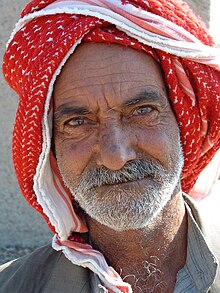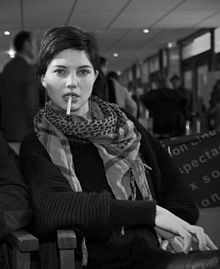Keffiyeh

The keffiyeh or kefije ( Arabic كوفية Keffiah , DMG Kūfīya , also Ghutra /غترة / Ġutra or Hatta /حطة / Ḥaṭṭa ) is a headscarf worn by men in the Arab world . The Arabic term is derived from the name of the Iraqi city of Kufa . The cloth is worn by Arabs to protect them from the sun. As a result of the Middle East conflict , the cloth came to be known as the Palestinian cloth . In army circles it's as Shemag /شماغ / šimāġ known.
shape
The keffiyeh is a square white cloth, sometimes with a tassel edge, usually made of cotton , which often has an evenly diced pattern in the middle, with stripes, mostly in black or red, but also blue and purple, woven or embroidered on the edge. Color and material vary regionally. In Saudi Arabia, the United Arab Emirates and Qatar, for example, the keffiyeh is almost always completely white, in Iraq, for example, it is mostly red and in Palestine black. In Palestine , many kufiyas are made from a wool / cotton blend.
There are two basic ways to use the keffiyeh:
- As a turban (the usual headgear in Oman ).
- After diagonal folding in the manner of a headscarf. In the latter case, it can be attached with an agal (also: Ogal , Iqal or Ekal ), a kind of cord , as a tether. In Palestine the keffiyeh is placed directly on the head, in the Emirates a hat is worn underneath. Each region has its own way of wearing the corners of the cloth in the front or back or folded up, etc., so that one can partly tell from the color and the way in which the kufiya is worn, from where it is being worn.
Kufiyas come in different qualities. In Europe you can often find cheap products. High-quality kufiyas can be recognized by the woven or interwoven pattern and the quality of the fabric.
origin
The keffiyeh originally comes from Kufa in Iraq and was initially worn by Bedouins and settled farmers in this region. The keffiyeh developed into a traditional garment throughout the Arab world and is still widespread today. The cloth is worn as headgear against intense solar radiation, but also serves as a protective cover for the eyes and mouth from dust and sand during desert storms. The traditional headgear exists in countless variations and colors. The keffiyeh is almost always made of white cotton and often has a checkered pattern in a certain color. The white keffiyeh is also called the ghutra and is especially worn in the Gulf states such as Saudi Arabia , Oman and Bahrain . Today “Palestinian towels” are mainly produced in China. The traditional manufacturers in the Palestinian Territories are largely displaced by competition. Hirbawi Textiles from Hebron (West Bank) is one of the last Palestinian producers.
The keffiyeh as the Palestinian national symbol

In the course of the Middle East conflict , the keffiyeh has developed into a symbol for the Palestinians fighting against Israel, so that it has often been known as the “Palestinian cloth” in German-speaking countries.
At the beginning of the 20th century, the keffiyeh in Palestine, like in other Arab countries, was a traditional and widespread headgear that was often worn, especially in rural areas. However, during the Arab uprising led by Grand Mufti Mohammed Amin al-Husseini from 1936 to 1939 against the mandate power of Great Britain , which administered Palestine on behalf of the League of Nations , the keffiyeh was politically afflicted for the first time. Representatives of the Arab upper class were forced by Husseini's people to wear the headgear of the Turkish occupiers and landowners instead of the traditional Ottoman fez , the keffiyeh as a sign of solidarity with the Arab fellahs .
The keffiyeh gained today's notoriety and designation as the Palestinian shawl from the late 1960s and 1970s through the leader of the Fatah organization, Yasser Arafat . The black and white keffiyeh has become Arafat's trademark, with which he appeared in public and made the cloth known worldwide. This is where the German name Arafat scarf comes from . Arafat carried the keffiyeh in his own way folded over his right shoulder in the shape of a triangle, so that the shawl is reminiscent of the borders of the Palestine region (including the state of Israel). In the Palestinian Territories, the black and white version of the keffiyeh is typical of Fatah, while sympathizers of left-wing organizations such as the PFLP preferred red kufiyas. However, this color assignment should not be overrated and is not generally recognized in Palestine.
Military use

During the Second World War , soldiers deployed in the Middle East and Arab North Africa, such as the Long Range Desert Group of the British Army, often took the Shemag into their equipment due to its comfort, without it becoming part of the official uniform. There have been similar developments in recent years with other Western armies on missions in regions where the keffiyeh is common, for example with the US Army and the German Armed Forces in Afghanistan. For the purpose of optical camouflage, the soldiers usually use olive green or khaki cloths with a black pattern to match the color of their uniform.
Keffiyeh in non-Arab countries
Since the days of the extra-parliamentary organized student protests of the 68s , the “Palituch” as a sign of solidarity with the PLO has been a popular symbol in left youth and subculture to express personal affiliation, especially to the anti-imperialist current within the politically left camp and the alternative scene . There it is understood as a sign of resistance against repression and as a symbol of personal freedom. It is also worn by hippies in this sense.



In the United States , the keffiyeh appeared in the late 1980s, at the time of the First Intifada , and experienced a further surge in popularity after the turn of the millennium. In addition, kufiyas with Jewish symbols came onto the market, which are also worn by Zionist activists.
Apart from its political importance, the Palestinian shawl is also often used in youth culture (for example Krocha ) in Germany and Austria as a fashion accessory without directly political symbolic content, especially by young people; the keffiyeh has found its way into apolitical youth and pop culture.
In particular, the political currents of anti-Germans and parts of the anti-national left criticize the wearing of the keffiyeh as a symbol of the struggle and terrorism against Israel.
In Germany, the keffiyeh has been worn increasingly by right-wing extremists and neo-Nazis (see for example the Free Comradeships ) since the late 1990s . This happens in the context of the use of left-wing symbols, which has often been observed in the right-wing extremist scene since the late 1990s, to portray themselves as socialist or revolutionary.
Web links
- Eberhardt Rathgeb: From booty to confession: the Palituch In: Frankfurter Allgemeine Zeitung . November 11, 2004
- Radical discourse cloth ( Memento from January 8, 2009 in the Internet Archive ) In: The daily newspaper about the Kufiya Feigale, March 28, 2008
- Jens Jessen : World revolution for domestic use In: Die Zeit. November 11, 2004
- Palestinian shawl fashion trend : “The ladies are really crazy about it” in Spiegel Online on the fashion trend in the Middle East, February 28, 2009
- The love of freedom: the Palestinian kerchief - fashion with a great history! (June 4, 2011)
Individual evidence
- ^ Palestinian cloth fights with copies from China FAZ.net, September 1, 2008, accessed January 15, 2013
- ↑ kufiyahirbawi.com
- ^ A b Where Some See Fashion, Others See Politics. New York Times, February 11, 2007.
- ↑ Avi Yellin: PA Angered by Israeli Keffiyeh . Israel National News, March 11, 2010
- ↑ See for example "Are you cold or do you have something against Jews ?!"
- ↑ Johanna Kramer: Neo-Nazis with Palestinian Shawls ( Memento of the original from January 4, 2016 in the Internet Archive ) Info: The archive link was inserted automatically and has not yet been checked. Please check the original and archive link according to the instructions and then remove this notice. , Saxon newspaper of May 10, 2004.
- ↑ Ulrich Gutmair: Radikaler Diskurslappen , Die Tageszeitung from March 28, 2008
- ↑ Timo Nowack and Markus Flohr: Disguised rights: stealth Nazis vying for young leftists , Spiegel-Online from May 1, 2007
- ↑ Thomas Grumke , Bernd Wagner (editor), handbook right-wing radicalism : people - organizations - networks from neo-Nazism to the middle of society, Leske + Budrich, Opladen 2002, new edition as e-book 2013 by Springer Science + Business Media, p. 219 .


